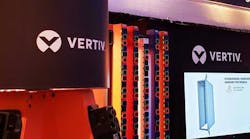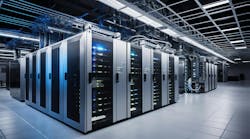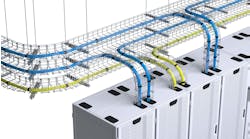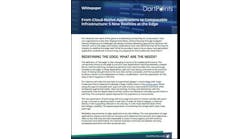Revved-Up Digital Transformation Among Anticipated Data Center Trends of 2021
John Hewitt, President of the Americas Region, Vertiv
The COVID-19 pandemic triggered global quarantines in 2020 that forced many businesses to fundamentally change the way they operate. The sudden shift to a broad work-from-home model strained networks and stretched the limits of VPNs never intended for simultaneous access from entire workforces. Collaboration tools became critical for online work and studies. The number of people using Zoom increased 2,900% in the first five months of 2020, while Microsoft Teams quickly set a new record for single-day meeting minutes at 2.7 billion.
Not surprisingly, as the pandemic stretches into 2021, many of those quick-response measures are evolving to something more permanent. This certainly is true in the data center. As Vertiv experts convened virtually for our annual discussion of data center trends to watch in the coming year, this rapid digitalization of the way we live and work topped the list. Here are two of five 2021 global data center trends identified by our experts as most impactful to the industry.
Digitalization on Fast Forward
Those early, cautious steps taken in response to the crisis will harden and new measures will be put into place as organizations accept these changes not as a temporary detour, but rather a permanent adjustment to the way we live and work.
Connectivity will be king, and remote monitoring, data analytics, and artificial intelligence will be essential to ensuring these distributed networks continue to meet the needs of our distributed populations and workforces. We expect pandemic-driven investment in IT infrastructure to continue and expand as the data center industry strives to deliver more secure, reliable and efficient remote work capabilities. Remote visibility and management will become paramount to the success of digital networks and their safe, efficient maintenance and service.
Data Center Recognized for Utility-Like Criticality
As the world makes this online migration more permanent, our experts anticipate widespread acceptance of the data center as something akin to a public utility, with expectations and responsibilities exceeding the industry’s already high standards. This may be surprising to some, considering even Tier 1 data centers profess 99.671% availability, but they will be expected to have the reliability the public has come to expect from telecom operators. Moving forward, the data center will be the hub of the digital economy at its most mission-critical, supporting increased reliance on telemedicine and health, enhanced e-commerce, and global telecommunications and mass media.
As the data center is recognized, at least informally, as a critical public utility, the expectations for availability and performance grow and the consequences for downtime become more severe. This will manifest in several ways, starting with the need to ensure the same levels of availability and application delivery in rural and remote areas. This will require data centers to maintain connectivity even at the outer limits of their networks, meaning increased vigilance on maintaining the reliability of edge sites. Any distinction between availability and connectivity will be erased, as the ability to ensure connections across these distributed hybrid networks will be every bit as important as any traditional measure of data center uptime.
Bottom line: The pandemic has changed the world in ways we couldn’t have anticipated just a year ago. The data center is among the most affected and will be central to managing changes across our society.
These are among the key 2021 data center trends as identified by a global team of data center experts across Vertiv. To learn more about these and other trends, including improved capabilities at the edge and increased focus on energy consumption and sustainability across the data center and 5G networks, visit Vertiv.com.
John Hewitt is the, President of the Americas Region for Vertiv.





